23.
Patient Teaching
Medicines for People With
Diabetes
 |
Do I need to take diabetes medicine? |
 |
Why do I need medicines for type 1
diabetes? |
 |
Why do I need medicines for type 2
diabetes? |
 |
What do I need to know about diabetes
pills? |
 |
What do I need to know about insulin? |
 |
Might I take more than one diabetes
medicine at a time? |
 |
What should I know about hypoglycemia
(low blood sugar)? |
 |
How do I know if my diabetes medicines
are working? |
 |
Specific medications |
- Diabetes pills
- Insulins
|
Do I Need to Take
Diabetes Medicine?
What if I have type 1 diabetes?
Type 1 is the type of diabetes that people most often get before 30 years of
age. All people with type 1 diabetes need to take insulin (IN-suh-lin)
because their bodies do not make enough of it. Insulin helps turn food into
energy for the body to work.
What if I have type 2 diabetes?
| Type 2 is the type of diabetes
most people get as adults after the age of 40. But you can also get this
kind of diabetes at a younger age.
Healthy eating, exercise, and losing weight may help
you lower your blood glucose (also called blood sugar) when you find out
you have type 2 diabetes. If these treatments do not work, you may need
one or more types of diabetes pills to lower your blood glucose. After a
few more years, you may need to take insulin shots because your body is
not making enough insulin. |
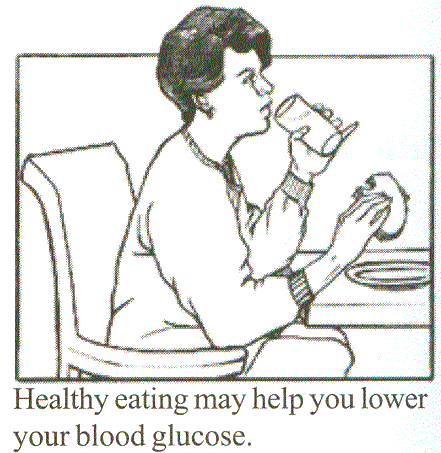 |
You, your doctor, and your diabetes teacher should always find
the best diabetes plan for you.
Why do I need medicines for type 1 diabetes?
| Most people make insulin in
their pancreas. If you have type 1 diabetes, your
body does not make insulin. Insulin helps glucose from the foods you eat
get to all parts of your body and be used for energy.
Because your body no longer makes insulin, you need to
take insulin in shots. Take your insulin as your doctor tells you. The
section What do I need to know about insulin? provides more information
on insulin. |
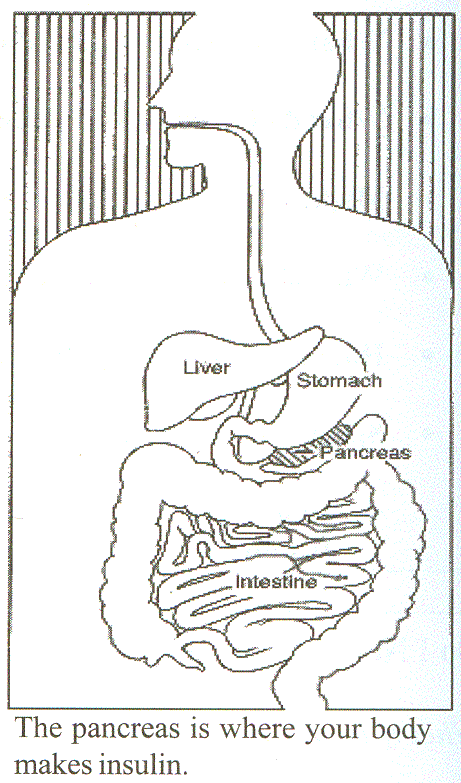 |
Specific Insulins
 |
Aspart (Novolog) |
 |
Insulin Glargine (Lantus) |
 |
Lente |
 |
Lispro (Humalog) |
 |
NPH |
 |
Premixed |
 |
Regular |
 |
Ultralente |
Why Do I Need Medicines for Type
2 Diabetes?
If you have type 2 diabetes, your pancreas usually makes plenty of
insulin. But your body cannot correctly use the insulin you make. You might get
this type of diabetes if members of your family have or had diabetes. You might
also get type 2 diabetes if you weigh too much or do not exercise enough.
After you have had type 2 diabetes for a few years, your body may stop making
enough insulin. Then you will need to take diabetes pills or insulin.
|
You need to know:
 |
Diabetes medicines that lower blood glucose never take
the place of healthy eating and exercise. |
 |
If your blood glucose gets too low more than a few times
in a few days, call your doctor. |
 |
Take your diabetes pills or insulin even if you are
sick. If you cannot eat much, call your doctor. |
|
What Do I Need to Know About
Diabetes Pill?
Many types of diabetes pills can help people with type 2 diabetes lower their
blood glucose. Each type of pill helps lower blood glucose in a different way.
The diabetes pill (or pills) you take is from one of these groups. You might
know your pill (or pills) by a different name.
 |
Sulfonylureas (SUL-fah-nil-YOO-ree-ahs). Stimulate your
pancreas to make more insulin. |
 |
Biguanides (by-GWAN-ides). Decrease the amount of glucose
made by your liver. |
 |
Alpha-glucosidase inhibitors (AL-fa gloo-KOS-ih-dayss in-HIB-it-ers).
Slow the absorption of the starches you eat. |
 |
Thiazolidinediones (THIGH-ah-ZO-li-deen-DYE-owns).
Make you more sensitive to insulin. |
 |
Meglitinides (meh-GLIT-in-ides).
Stimulate your pancreas to make more insulin. |
 |
D-phenylalanine (dee-fen-nel-AL-ah-neen)
derivatives. Help your pancreas make more insulin quickly. |
 |
Combination oral medicines.
Put together different kinds of pills. |
Specific pills
|
Actos
Amaryl
Avandia
DiaBeta
Diabinase
Dymelor
Glucophage
Glucophage XR
Glucotrol
Glucotrol XL |
Glucovance
Glynase PresTab
Glyset
Micronase
Orinase
Prandin
Precose
Starlix
Tolinase |
 |
|
Oral Drugs
Adults with Type 2 diabetes may or may not be treated with one or more
classes of oral diabetes drugs. The oldest class, sulfonylureas (SFUs), act
on the pancreatic tissue to produce insulin. The newest one is Amaryl (glimepiride)
approved by FDA in 1996.
Because SFUs can become less effective after 10 or more years of use,
other drugs often are needed. Another class is the biguanides, including
metformin, which was approved by FDA in 1995. This drug acts by lowering
cells’ resistance to insulin, a common problem in Type 2 diabetes. A third
class is the alpha-glucosidase inhibitors, which include Precose (acarbose),
approved by FDA in 1995, and Glyset (miglitol), approved in 1996. These
drugs slow the body’s digestion of carbohydrates, delaying absorption of
glucose from the intestines.
A newer class of diabetes drugs is the thiazolidinediones. They include
Rezulin (troglitazone), approved in 1997, and Avandia and Actos, both
approved in 1999. These drugs improve a condition that seems to be an
important underlying cause of adult onset diabetes—resistance of the body
to insulin.
Though they act similarly, their approved uses
vary. Rezulin, for example, is approved for use in combination with
sulfonyureas and metformin. It should not be used as an initial
single agent therapy and should be prescribed only in patients not
adequately controlled by other therapies.
FDA approved Avandia for patients with diabetes
who are not taking insulin and Actos for diabetics who are not
adequately controlled by diet and exercise alone. Actos is approved
for use with sulfonylureas, metformin or insulin in patients who are
not adequately controlled on the these agents alone.
FDA recommends regular liver chemistry tests for
patients receiving a thiazolidinedione. This recommendation is based
on evidence of serious and sometimes fatal liver injury in patients
treated with Rezulin. Though liver disease was not seen in clinical
trials of Avandia and Actos, FDA recommends liver tests for patients
on any of the approved thiazolidinediones. The recommendations are
as follows:
For patients on Rezulin, liver function tests
should be done before the patient starts therapy, monthly during the
first year of Rezulin therapy, and quarterly thereafter.
For patients on Actos and Avandia, liver function
tests should be performed at the start of therapy, every two months
during the first year of treatment, and periodically thereafter.
Symptoms suggesting liver problems include
unexplained nausea, vomiting, stomach pain, tiredness, loss of
appetite, dark urine or yellowing of skin (jaundice). If any of
these symptoms occur, liver enzymes should be checked. If the
patient develops jaundice, he or she should stop the drug therapy.
Another new class of oral blood glucose-lowering
drugs, the meglitinides, was introduced in December 1997 when FDA
approved Prandin (repaglinide). These drugs work like the SFUs.
Prandin is taken two, three, or four times a day usually about 15
minutes before meals. The advantage of this medicine is that, like
the short-acting SFUs, it provides convenience to patients who are
not on a regular eating schedule. Also, it may reduce the potential
for serious hypoglycemia (low blood sugar), the most important
adverse reaction of SFU therapy. Prandin is approved for use alone
or in combination with metformin. |
Questions to ask about your diabetes medicines?
Ask these questions when your doctor prescribes a medicine. Write the
answers in pencil so that you can make changes if your doctor changes your
medicines.
 | When do I take the medicine–before a meal, with a meal, or after
a meal? |
 |
How often should I take the medicine? |
 |
Should I take the medicine at the same time every day? |
 |
What should I do if I forget to take my medicine? |
 |
What side effects may happen? |
 |
What should I do if I get side effects? |
My diabetes medicines
Fill in the names of your diabetes medicines, when you should take them,
and how much you should take. Your doctor or diabetes teacher can help you
fill in this record. Write this in pencil so you can make changes when your
doctor makes changes in your diabetes medicines.
• Name of medicine: __________________________________
Time: __________ Meal: ___________________________
How much: ________________________________________
• Name of medicine: __________________________________
Time: __________ Meal: ___________________________
How much: ________________________________________
• Name of medicine: __________________________________
Time: __________ Meal: ___________________________
How much: ________________________________________
• Name of medicine: __________________________________
Time: __________ Meal: ___________________________
How much: ________________________________________
• I should call my doctor or diabetes teacher if I have these
problems with my diabetes medicines:
__________________________________________________
__________________________________________________
• I should call my doctor or diabetes teacher if my
blood glucose is too low or too high for several days.
Too low is _______ mg/dL for _______ days.
Too high is _______ mg/dL for _______ days.
• My blood glucose should be between _________ mg/dL and
_________ mg/dL before my first meal of the day.
• My blood glucose should be between _________ mg/dL and
_________ mg/dL 1 to 2 hours after a meal.
• My blood glucose is too low at ___________________ mg/dL.
• My blood glucose is too high at ___________________
mg/dL.
• My hemoglobin A-1-c should be ___________________%.
What are side effects?
 |
Side effects are changes that may happen in your body when you take a
medicine. When your doctor gives you a new medicine, ask what the side
effects might be. |
 |
Some side effects happen just when you start to take the medicine.
Then they go away. |
 |
Some side effects happen only once in a while. You may get used to
them or learn how to manage them. |
 |
Some side effects will cause you to stop taking the medicine. Your
doctor may try another one that doesn’t cause you side effects. |
What Do I Need to
Know About Insulin?
If your pancreas no longer makes enough insulin, then you need to take
insulin as a shot. You inject the insulin just under the skin with a small,
short needle.
Can insulin be taken as a pill?
Insulin is a protein. If you took insulin as a pill, your body would break it
down and digest it before it got into your blood to lower your blood glucose.
How does insulin work?
Insulin lowers blood glucose by moving glucose from the blood
into the cells of your body. Once inside the cells, glucose provides energy.
Insulin lowers your blood glucose whether you eat or not. You should eat on time
if you take insulin.
How often should I take insulin?
Most people with diabetes need at least two insulin shots a
day for good blood glucose control. Some people take three or four shots a day
to have a more flexible diabetes plan.
When should I take insulin?
You should take insulin 30 minutes before a meal if you take
regular insulin alone or with a longer-acting insulin. If you take a
rapid-acting insulin, you should take your shot just before you eat.
Are there several types of insulin?
Yes. There are five main types of insulin. They each work at
different speeds. Many people take two types of insulin.
Does insulin work the same all the time?
After a short time, you will get to know when your insulin
starts to work, when it works its hardest to lower blood glucose , and when it
finishes working.
You will learn to match your mealtimes and exercise times to
the time when each insulin dose you take works in your body.
How quickly or slowly insulin works in your body depends on
 |
your own response |
 |
the place on your body where you inject insulin. |
 |
the type and amount of exercise you do and the length
of time between your shot and exercise. |
Where on my body should I inject insulin?
| You can inject insulin into
several places on your body. Insulin injected near the stomach works
fastest. Insulin injected into the thigh works slowest. Insulin injected
into the arm works at medium speed. Ask your doctor or diabetes teacher
to show you the right way to take insulin and in which parts of the body
to inject it. |
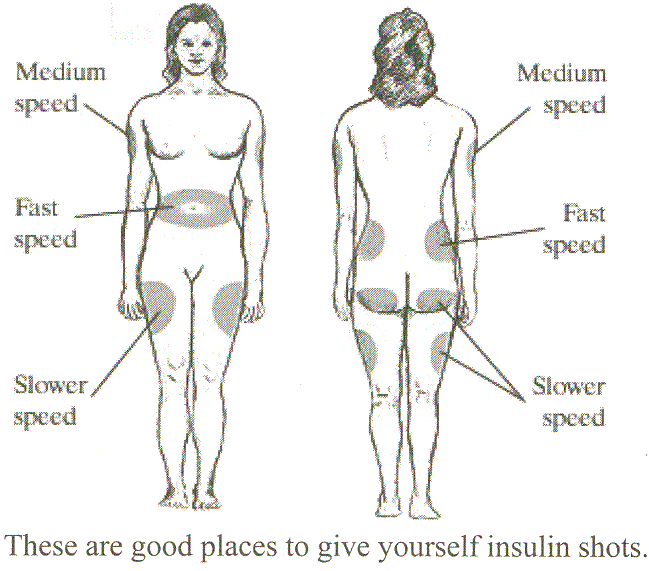 |
How should I store insulin?
 |
If you use a whole bottle of insulin within 30 days,
keep that bottle of insulin at room temperature. On the label, write the date
that is 30 days away. That is when you should throw out the bottle with any
insulin left in it. |
 |
If you do not use a whole bottle of insulin within 30
days, then store it in the refrigerator all the time. |
 |
If insulin gets too hot or cold, it breaks down and does
not work. So, do not keep insulin in very cold places such as the freezer, or
in hot places, such as by a window or in the car’s glove compartment during
warm weather. |
 |
Keep at least one extra bottle of each type of insulin
you use in your house. Store extra insulin in the refrigerator. |
|
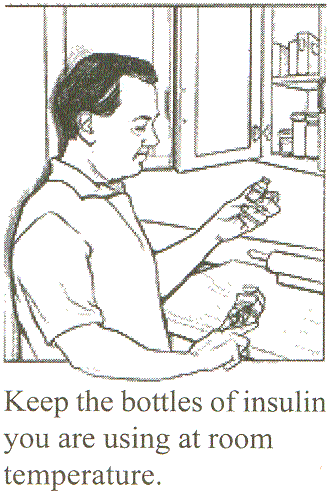 |
What are possible side effects of insulin?
 |
hypoglycemia |
 |
weight gain |
Might I Take More Than One Diabetes
Medicine at a Time?
Yes. Your doctor may ask you to take more than one diabetes
medicine at a time. Some diabetes medicines that lower blood glucose work well
together. Here are examples:
Two diabetes pill
If one type of pill alone does not control your blood glucose,
then your doctor might ask you to take two kinds of pills. You may take two
separate pills or one pill that combines two medicines. Each type of pill has
its own way of acting to lower blood glucose . Here are pills used together:
 |
a sulfonylurea and metformin |
 |
a sulfonylurea and acarbose |
 |
metformin and acarbose |
 |
repaglinide and metformin |
 |
nateglinide and metformin |
 |
pioglitazone and a sulfonylurea |
 |
pioglitazone and metformin |
 |
rosiglitazone and metformin |
 |
rosiglitazone and a sulfonylurea |
Diabetes pills and insulin
Your doctor might ask you to take insulin and one of these diabetes pills:
 |
a sulfonylurea |
 |
metformin |
 |
pioglitazone |
What Should I Know About Hypoglycemia
(low blood pressure)?
Sulfonylureas, meglitinides, D-phenylalanine derivatives,
combination oral medicines, and insulin are the types of diabetes medicines that
can make blood glucose go too low.
Hypoglycemia can happen for many reasons:
 |
delaying or skipping a meal |
 |
eating too little food at a meal |
 |
getting more exercise than usual |
 |
taking too much diabetes medicine |
 |
drinking alcohol |
You know your blood glucose may be low when you feel one or more of the
following:
 |
dizzy or light-headed |
 |
hungry |
 |
nervous and shaky |
 |
sleepy or confused |
 |
sweaty |
|
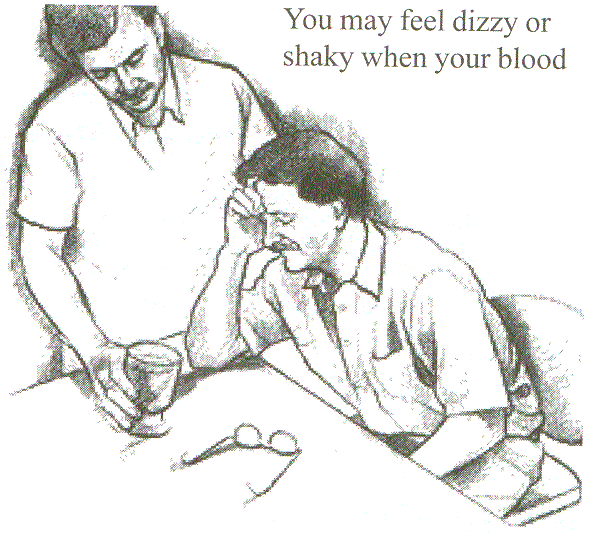 |
If you think your blood glucose is low, test it to see for sure. If your
blood glucose is at or below 70 mg/dL, have one of these items to get 15 grams
of carbohydrate:
 |
1/2 cup (4 oz.) of any fruit juice |
 |
1 cup (8 oz.) of milk |
 |
1 or 2 teaspoons of sugar or honey |
 |
1/2 cup (4 oz.) of regular soda |
 |
5 or 6 pieces of hard candy |
 |
glucose gel or tablets (take the amount noted on the
package to add up to 15 grams of carbohydrate) |
Test your blood glucose again 15 minutes later. If it is still below 70 mg/dL,
then eat another 15 grams of carbohydrate. Then test your blood glucose again
in 15 minutes.
If you cannot test your blood glucose right away but you feel symptoms of
hypoglycemia, eat one of the items listed above.
If your blood glucose is not low, but you will not eat your next meal for
at least an hour, then have a snack with starch and protein. Here are some
examples:
 |
crackers and peanut butter or cheese |
 |
half of a ham or turkey sandwich |
 |
a cup of milk and crackers or cereal |
How Do I Know If My Diabetes
Medicines Are Working?
Learn to test your blood glucose. Ask your doctor or diabetes teacher about
the best testing tools for you and how often to test. After you test your
blood glucose, write down your blood glucose test results. Then ask your
doctor or diabetes teacher if your diabetes medicines are working. A good
blood glucose reading before meals is between 70 and 140 mg/dL.
Ask your doctor or diabetes teacher about how low or how high your blood
glucose should get before you take action. For many people, blood glucose is
too low below 70 mg/dL and too high above 240 mg/dL.
One other number to know is the result of a blood test your doctor does
called hemoglobin A-1-c (HE-muh-glow-bin A-1-C) or glycated hemoglobin
(GLY-kay-ted HE-muh-glow-bin). It shows your blood glucose control
during the past 2 to 3 months. For most people, a good hemoglobin A-1-c is 7
percent.



